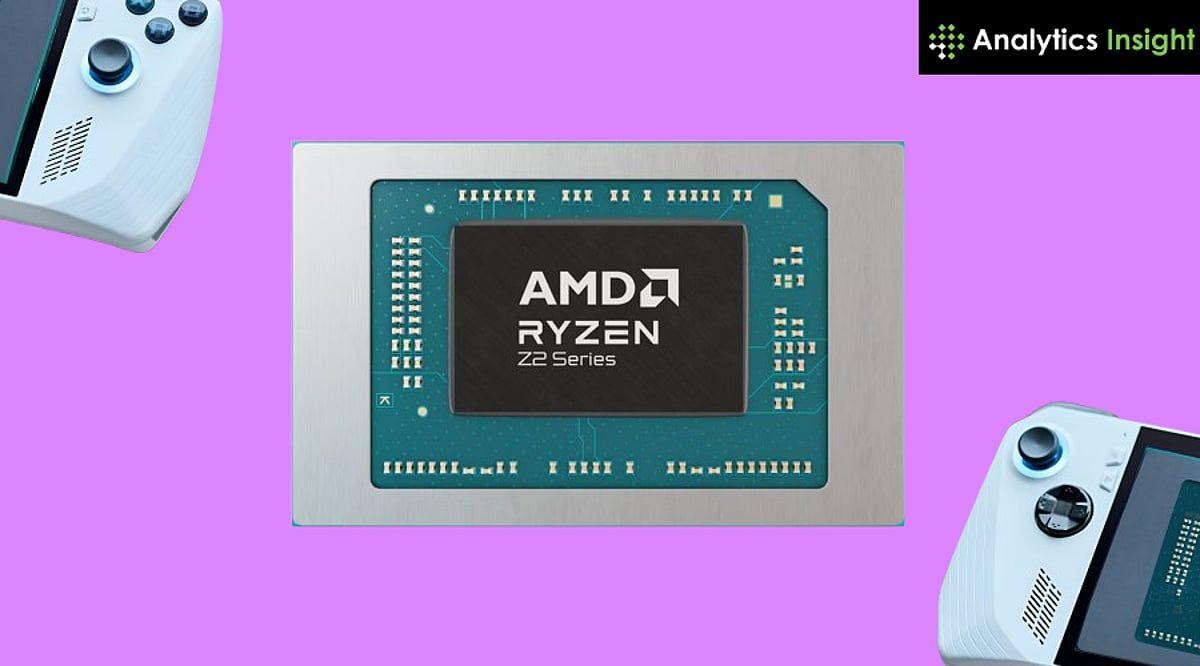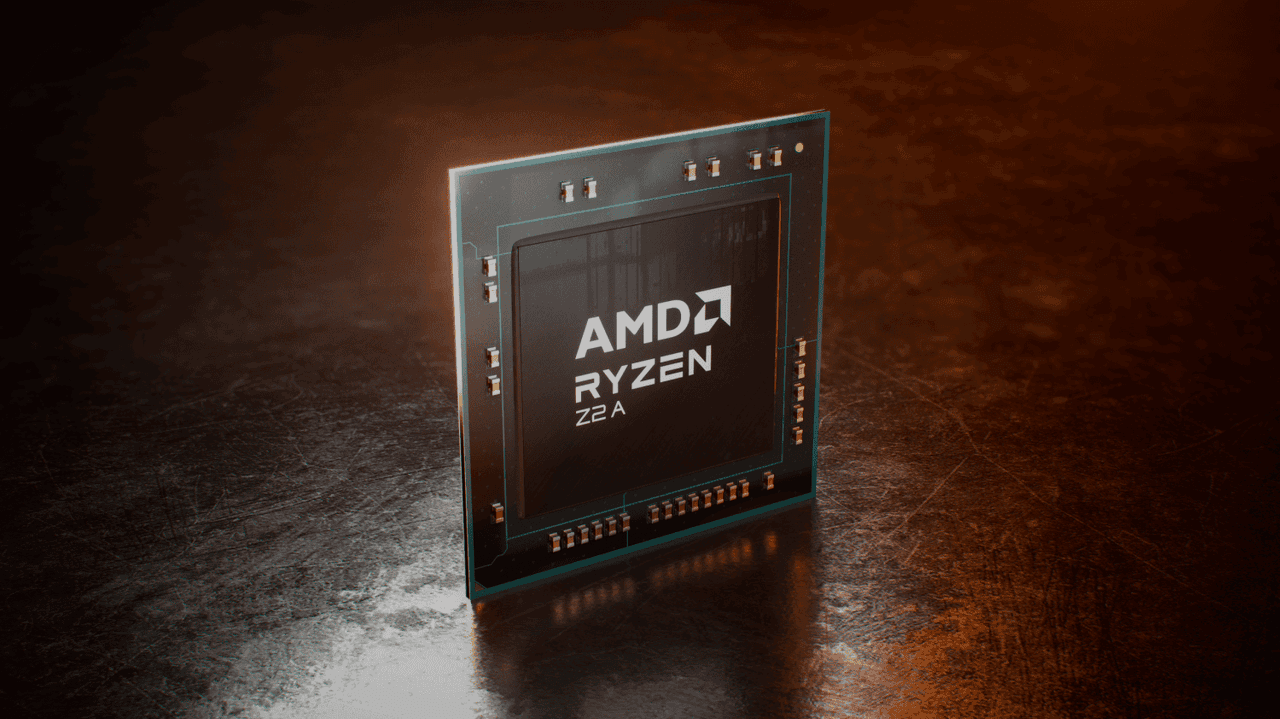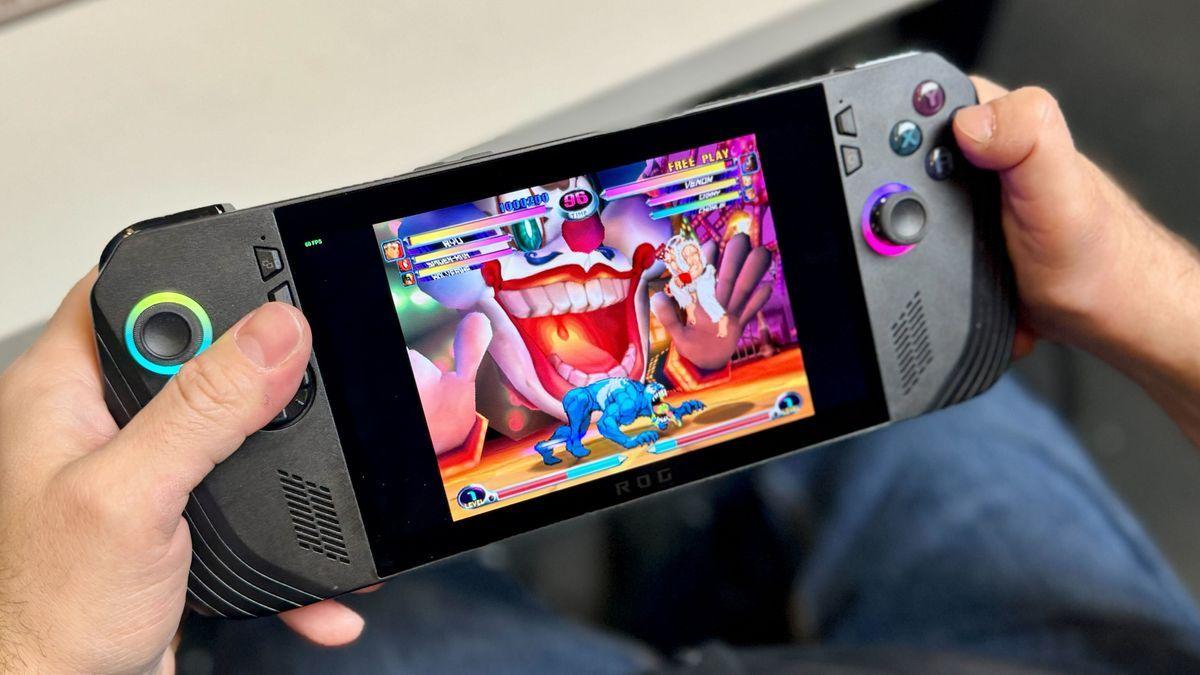AMD Unveils Ryzen AI Z2 Extreme: Bringing AI Power to Gaming Handhelds
5 Sources
5 Sources
[1]
AMD unveils Ryzen AI Z2 Extreme and Z2 A chips powering Xbox gaming handhelds
Serving tech enthusiasts for over 25 years. TechSpot means tech analysis and advice you can trust. What just happened? AMD has expanded its Ryzen Z2 family of processors for gaming handhelds by announcing two new APUs: the Ryzen AI Z2 Extreme and Ryzen Z2 A. These chips power the newly launched Xbox-branded gaming handhelds - the ROG Xbox Ally and ROG Xbox Ally X. Designed for flagship devices, the Ryzen AI Z2 Extreme is the more premium of the two. According to AMD's official spec sheet, it is virtually identical to the Strix Point-based Ryzen Z2 Extreme, which powers handhelds like the MSI Claw A8, but with the addition of an NPU offering 50 TOPS of AI compute power. Other specs include an 8-core, 16-thread CPU, comprising five Zen 5 cores and three Zen 5C cores. The chip also features 16 RDNA 3.5 graphics compute units, 24MB of cache, and support for LPDDR5X-8000 memory. AMD has not published the clock speeds, but the existing Z2 Extreme features a 2GHz base clock for all cores, a boost clock up to 3.3GHz for the Zen 5C cores, and up to 5GHz boost clock for the Zen 5 cores. The new chip retains the same 15W to 35W TDP range as the non-AI Z2 Extreme. Explaining the rationale behind adding an NPU to a processor designed for gaming handhelds, AMD told PC Gamer that it would bring "low-power, on-device AI capabilities" to handheld gaming for the first time - enabling upscaling, adaptive gameplay, and smarter NPCs. Beyond enabling new features, the NPU is also expected to improve performance and battery life by offloading AI processing, allowing the CPU and GPU to focus on core game tasks. AMD added that the neural processor will support AI-enabled gaming with "real-time personalization and smarter, more interactive gameplay." In addition to the Ryzen AI Z2 Extreme, AMD also announced the Ryzen Z2 A, designed for entry-level gaming handhelds. It features a 4-core, 8-thread CPU based on the older Zen 2 architecture, eight RDNA 2 graphics cores, 6MB of cache, and support for LPDDR5-6400 memory. It has a configurable TDP ranging from 6W to 20W. The new chips power the latest "Xbox" gaming handhelds announced this week by Microsoft and Asus. While the top-end ROG Xbox Ally X uses the Ryzen AI Z2 Extreme, the more affordable ROG Xbox Ally is equipped with the Ryzen Z2 A. Both devices are expected to launch in time for the holiday shopping season.
[2]
AMD's Ryzen Z2 Extreme just brought AI to handhelds -- should the competition be worried?
With 50 TOPS of AI firepower, should Intel, Qualcomm, and Nvidia be paying attention? AMD's new Ryzen Z2 Extreme lineup has just been expanded with a game-changing twist: A built-in AI engine capable of 50 TOPS (trillion operations per second) of on-device AI compute. That puts it well above Microsoft's 40 TOPS Copilot+ PC requirement, and ahead of Intel's upcoming Lunar Lake platform and Qualcomm's flagship Snapdragon X Elite. What sets this chip apart is its AI credentials and the fact that it delivers this power in a 35-watt envelope, making it suitable for compact handheld devices and ultra-portable laptops. The Ryzen Z2 Extreme is built on AMD's new Zen 5 CPU architecture, paired with RDNA 3.5 integrated graphics and support for LPDDR5X-8000 memory. It features 8 cores and 16 threads with up to 24MB of cache and a Radeon GPU with 16 compute units. The NPU is based on AMD's second-generation XDNA architecture, which handles AI inference without drawing heavily on CPU or GPU resources. This chip is a direct successor to the Ryzen Z1 Extreme, which powered high-end handhelds like the original ROG Ally. It significantly upgrades efficiency, graphics performance, and AI capabilities. The dedicated NPU is capable of offloading Windows Studio Effects, AI-driven upscaling, noise suppression, and even real-time virtual assistant features, all of which run locally. Not everyone is thrilled by AMD's approach. Critics point out that the Z2 lineup actually comprises four different generations of silicon under a single name. PC Gamer emphasizes how Ryzen Z2 A appears to be nothing more than a rebranded Steam Deck's Van Gogh APU, with old Zen 2 CPU cores and RDNA 2 GPU, despite AMD pretending it's fresh silicon. Similarly, the Ryzen AI Z2 Extreme is simply the existing Strix Point Z2 Extreme chip with the NPU enabled; there are no changes to core or GPU configurations beyond flipping on the AI engine. Critics argue that this muddied naming strategy makes it harder for consumers to understand what they're buying. Others also question the NPU's real-world impact. While the presence of AI hardware brings potential for on-device features such as adaptive gameplay and upscaling, some argue that RDNA 3.5 still lags behind AMD's desktop RDNA 4 and far behind Nvidia's Tensor core-equipped GPUs. At best, the benefit is currently theoretical. AMD's new chips are arriving just in time for a wave of next-generation handhelds. Asus has already confirmed that it's building new devices around the Z2 series. The Asus ROG Ally X is expected to feature the Ryzen Z2 Extreme, while Lenovo's Legion Go 2 and Go S are set to include both high-end and lower-tier options. Lenovo and MSI have also confirmed new devices around the Z2 series. MSI is adding a Z2 Extreme configuration to its Claw handheld, while Lenovo's Legion Go 2 and Go S are set to include both high-end and lower-tier options. AMD's move into AI-capable handheld chips puts pressure on Intel and Qualcomm. The Core Ultra 7 155H includes an integrated NPU rated at about 11 TOPS, while Qualcomm's Snapdragon X Elite offers up to 45 TOPS. Intel's upcoming Lunar Lake platform is also expected to reach 45 TOPS. By delivering 50 TOPS in a power envelope that works in handheld devices, AMD currently holds the edge in AI performance per watt. Unlike Snapdragon chips, AMD's processors are x86-based, meaning they offer full compatibility with the existing Windows game library. That remains a major advantage for handheld PCs. Combining high-end gaming performance with serious AI power, AMD is clearly looking to take the lead in bringing AI into the gaming handheld space. And with strong OEM support and a lineup that covers both premium and entry-level use cases, the Ryzen Z2 series may well power the next wave of portable PCs. If you're waiting for a handheld that can handle both AAA games and AI workflows, AMD just gave you 50 trillion reasons to pay attention.
[3]
Ryzen Z2 Series CPU and GPU Specs: Zen 5, Zen 4, Zen 3+ and RDNA Architectures
AMD has recently expanded its Ryzen Z2 processor lineup with two new models: the Ryzen AI Z2 Extreme and the Ryzen Z2 A. These new processors appeared in leaks ahead of AMD's planned Computex 2025 presentation. The AI Z2 Extreme is positioned as the top-tier offering, designed for more demanding tasks, while the Z2 A serves as an entry-level option. The Ryzen AI Z2 Extreme is based on AMD's latest Zen 5 core design and incorporates a Neural Processing Unit (NPU) to boost AI-related performance. This NPU can handle up to 50 trillion operations per second (TOPS), making it suitable for workloads that require on-device AI acceleration. The processor features eight CPU cores paired with a GPU using AMD's RDNA 3.5 architecture, along with the XDNA 2 NPU framework. Its internal codename is "Strix Point." On the other hand, the Ryzen Z2 A is built on an older Zen 2 architecture with four CPU cores and integrates an RDNA 2 GPU. This model goes by the codename "Van Gogh." The Ryzen Z2 family includes other processors like the Ryzen Z2 Extreme, Ryzen Z2, and Ryzen Z2 Go, each based on different CPU architectures -- Zen 5, Zen 4, and Zen 3+ respectively -- and various GPU configurations. These chips are featured in products such as Lenovo's Legion Go S, MSI's Claw A8, and Asus ROG's Xbox Ally handheld devices. The power consumption of these processors varies from as low as 6 watts in the Ryzen Z2 A to a maximum of 35 watts for the AI Z2 Extreme, reflecting different performance and efficiency targets across the series. This processor lineup illustrates AMD's strategy of mixing different CPU and GPU architectures within a single product family to address a range of performance and power requirements. The integration of an NPU in the AI Z2 Extreme highlights AMD's focus on AI workloads as a growing segment of computing needs. Overall, the Ryzen Z2 series caters to compact, portable devices such as handheld gaming consoles and ultraportable laptops where efficient power usage and AI capabilities are increasingly important. SKU Codename CPU Architecture CPU Cores GPU Architecture NPU Typical Board Power (TBP) Ryzen AI Z2 Extreme Strix Point Zen 5 + Zen 5c 8 RDNA 3.5 (16 Compute Units) XDNA 2 (NPU, 50 TOPS) 15 - 35 W Ryzen Z2 Extreme Strix Point Zen 5 + Zen 5c 8 RDNA 3.5 (16 Compute Units) None Not specified Ryzen Z2 Hawk Point Zen 4 8 RDNA 3 (12 Compute Units) None Not specified Ryzen Z2 Go Rembrandt Zen 3+ 8 RDNA 3 (12 Compute Units) None Not specified Ryzen Z2 A Van Gogh Zen 2 4 RDNA 2 (8 Compute Units) None 6 - 20 W Ryzen Z1 Extreme Phoenix Zen 4 8 RDNA 3 (12 Compute Units) None 9 - 30 W Ryzen Z1 Phoenix Zen 4 + Zen 4c 6 RDNA 3 (4 Compute Units) None Not specified
[4]
AMD unveils new budget, high-end SoCs: enter the Ryzen AI Z2 A and Ryzen AI Z2 Extreme chips
As an Amazon Associate, we earn from qualifying purchases. TweakTown may also earn commissions from other affiliate partners at no extra cost to you. AMD has officially expanded its family of Ryzen Z2 SoCs with the introduction of the new Ryzen Z2 A and higher-end Ryzen AI Z2 Extreme handheld chips. A few months ago, AMD unveiled its new custom Ryzen Z2 chips for gaming handhelds with the Ryzen Z2 Extreme, Ryzen Z2, and Ryzen Z2 Go. The first two -- the Ryzen Z2 Extreme and Ryzen Z2 -- are based on the Zen 5 and Zen 4 architectures, while the Ryzen Z2 Go is a Lenovo gaming handheld exclusive, and based on the Zen 3+ architecture. But now, AMD has expanded the family of gaming handheld SoCs with the new Ryzen AI Z2 Extreme virtually identical to the Ryzen Z2 Extreme, but the new Ryzen AI Z2 Extreme has a dedicated NPU for AI workloads on a gaming handheld (because we all want and need that). Inside, the new Ryzen AI Z2 Extreme SOC has 8 cores and 16 threads based on the new Zen 5 architecture, with an RDNA 3.5-based GPU with 16 cores at the ready. We should see performance that is close to the Radeon 890M integrated GPU, which also has 16 cores based on the RDNA 3.5 GPU architecture. We have a 15-25W configurable TDP and Copilot+ PC ready on the Ryzen AI Z2 Extreme chip. The lower-end Ryzen Z2 A drops the integrated NPU, and lowers the CPU core and thread count down to 4 CPU cores and 8 threads based on the Zen 2 architecture. It also has a far less powerful integrated GPU which is based on the older-gen RDNA 2 architecture, with just 8 GPU cores in total and a 6-20W TDP. AMD notes that it has its Ryzen AI Z2 Extreme SoC inside of the just-announced ASUS ROG Ally X gaming handheld, the Ryzen Z2 Extreme inside of the MSI Claw 8, and the Ryzen Z2 inside of the ASUS ROG Ally (non-X) and the Lenovo Legion Go S gaming handhelds.
[5]
AMD's Ryzen AI Z2: Powering the Future of Portable Gaming
Enables next-gen handhelds: Powers thinner, lighter devices with extended battery life through AI. The portable gaming world is about to encounter a revolutionary change since silicon design has evolved to produce unprecedented performance and efficiency. Powering the forefront of this evolution is AMD, whose Ryzen AI Z2 processor will emerge as the defining force at the pinnacle of handheld gaming expectations. Information about the Z2 is still emerging. However, building on its predecessors' success, the Z2 is expected to set a new standard. It will feature cutting-edge CPU, GPU, and AI capabilities in a single power-efficient package. This combination could truly be game-changing for portable entertainment.
Share
Share
Copy Link
AMD introduces the Ryzen AI Z2 Extreme chip with integrated AI capabilities, designed for high-performance gaming handhelds and ultraportable devices.
AMD Introduces Ryzen AI Z2 Extreme for Gaming Handhelds
AMD has expanded its Ryzen Z2 family of processors with the introduction of the Ryzen AI Z2 Extreme, a new chip designed for high-performance gaming handhelds and ultraportable devices
1
2
. This latest addition brings significant advancements in AI capabilities to the portable gaming market.
Source: Analytics Insight
Powerful Specifications and AI Integration
The Ryzen AI Z2 Extreme boasts impressive specifications, including:
- 8 cores and 16 threads based on the Zen 5 architecture (5 Zen 5 cores and 3 Zen 5C cores)
- 16 RDNA 3.5 graphics compute units
- 24MB of cache
- Support for LPDDR5X-8000 memory
- A configurable TDP range of 15W to 35W
1
3
What sets this chip apart is its integrated Neural Processing Unit (NPU), capable of delivering 50 TOPS (trillion operations per second) of AI compute power
2
4
. This puts the Ryzen AI Z2 Extreme ahead of competitors like Intel's upcoming Lunar Lake platform and Qualcomm's Snapdragon X Elite in terms of AI performance per watt2
.Enhancing Gaming Experiences with AI
AMD claims that the addition of an NPU to gaming handhelds will enable:
- Low-power, on-device AI capabilities
- Improved upscaling
- Adaptive gameplay
- Smarter NPCs
- Real-time personalization
- More interactive gameplay
1
2
The NPU is expected to enhance overall performance and battery life by offloading AI processing tasks, allowing the CPU and GPU to focus on core gaming functions
1
.New Devices Powered by Ryzen Z2 Series
The Ryzen AI Z2 Extreme is already set to power several upcoming gaming handhelds:
- ROG Xbox Ally X by Asus and Microsoft
- MSI Claw A8
- Lenovo Legion Go 2
1
2
4
Additionally, AMD introduced the Ryzen Z2 A, an entry-level chip for more affordable gaming handhelds. It features a 4-core, 8-thread CPU based on the older Zen 2 architecture, eight RDNA 2 graphics cores, and a TDP range of 6W to 20W
1
3
.
Source: TweakTown
Related Stories
Industry Impact and Competition
AMD's move into AI-capable handheld chips puts pressure on competitors like Intel and Qualcomm. The Ryzen AI Z2 Extreme's 50 TOPS of AI performance in a power envelope suitable for handheld devices gives AMD an edge in AI performance per watt
2
.Unlike Qualcomm's Snapdragon chips, AMD's x86-based processors offer full compatibility with the existing Windows game library, which remains a significant advantage for handheld PCs
2
.Criticisms and Challenges
Despite the advancements, some critics have raised concerns about AMD's naming strategy for the Z2 lineup, which comprises four different generations of silicon under a single name. This approach has been criticized for potentially confusing consumers
2
.
Source: TechSpot
Additionally, questions remain about the real-world impact of the NPU, with some arguing that the benefits are currently theoretical and that the RDNA 3.5 GPU still lags behind AMD's desktop RDNA 4 and Nvidia's Tensor core-equipped GPUs
2
.As the gaming handheld market continues to evolve, AMD's Ryzen AI Z2 Extreme represents a significant step forward in bringing AI capabilities to portable gaming devices. The coming months will likely reveal how these advancements translate into real-world gaming experiences and whether they will drive the next wave of innovation in the handheld PC market.
References
Summarized by
Navi
[2]
[4]
[5]
Related Stories
Recent Highlights
1
OpenAI releases GPT-5.2 AI model after code red memo targets Google's Gemini 3 threat
Technology

2
Disney invests $1 billion in OpenAI, licenses 200+ characters for Sora AI video generator
Technology

3
OpenAI faces wrongful death lawsuit after ChatGPT allegedly fueled murder-suicide tragedy
Policy and Regulation








